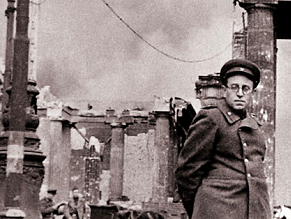|
World Jewish News

Vasilii Grossman, a famous Soviet Jewish writer and journalist. (Courtesy Yad Vashem)
|
Yad Vashem marks diversity, bravery of Red Army Jews
12.08.2015, Israel A new, online exhibit at Yad Vashem recounts the powerful and personal stories of 100 soldiers in the Soviet Union’s Red Army, a lesser-known side of the Holocaust story.
There were between 350,000 to 500,000 Jews in the Red Army during the war, and about 140,000 were killed, said Dr. Arkadi Zeltser, who directed the Yad Vashem project, supported by the Blavatnik Family Foundation.
The goal of the project, titled “Jews in the Red Army,” Zeltser said, was to tell the individual histories of some of the soldiers.
“It’s difficult to find what people felt during the war,” Zeltser said. “For us, it was important to give them an opportunity to speak.”
The Yad Vashem research team spent a year combing through both official documents, such as Russian military records and personal accounts of the war, like diaries and letters. They also used coverage of the war by the Yiddish language press and published materials from Jewish anti-fascist groups.
The researchers found official documents for those featured in the exhibit, confirming their Jewish identities, which was not always an easy task. Some were not identified as Jewish in documents, such as one soldier who had a father who was a rabbi and a brother in a yeshiva, but was listed as a Lithuanian national. There were men and women represented, serving in a wide range of military units, such as the air force, armored corps, submarines and intelligence agencies. The women were medical staff, as well as fighters, translators and propagandists against the Nazis.
Zeltser and his team focused on the soldiers’ Jewish backgrounds, many of whom addressed anti-Semitism and the Holocaust in their diaries and personal letters. Their documents showed they were motivated by both their Jewish and national backgrounds to fight for the Soviet Union and oppose the Nazis.
Some would go on to received the Hero of the Soviet Union Award, the country’s highest distinction.
The Jews in the Red Army were a diverse group, and the project looked for soldiers from a variety of backgrounds. Not all were Ashkenazi Jews, Zeltser said, and the project includes individuals from smaller Jewish groups such as Mountain Jews native to the Caucasus Mountains, Bukharan Jews from Central Asia, and Krymchaks, a small Jewish community from Crimea.
Lithuanian Vulf Vilenskii, a member of the socialist Zionist movement, Hashomer Hatzair, was called to serve in the Lithuanian army in 1940, and went into the Red Army when his country was annexed by the Soviet Union. He became an officer and was sent to the front lines in 1941, first fighting in Belorussia before being placed in a Lithuanian infantry division.
Ethnic Lithuanian and Latvian military divisions were up to 23 percent Jewish and soldiers commonly spoke Yiddish. Vilenskii was wounded four times during the war, and most of his family was killed by the Nazis. He received several military commendations, including the Hero of the Soviet Union award after halting a German offensive near the Lithuanian city of Klaipeda.
Vilenski continued his military career in the Soviet Union and went on to write for a Yiddish newspaper before making aliyah in 1983 to join his children and their families in Israel. He died in 1992.
By Luke Tress
The Times of Israel
|
|
